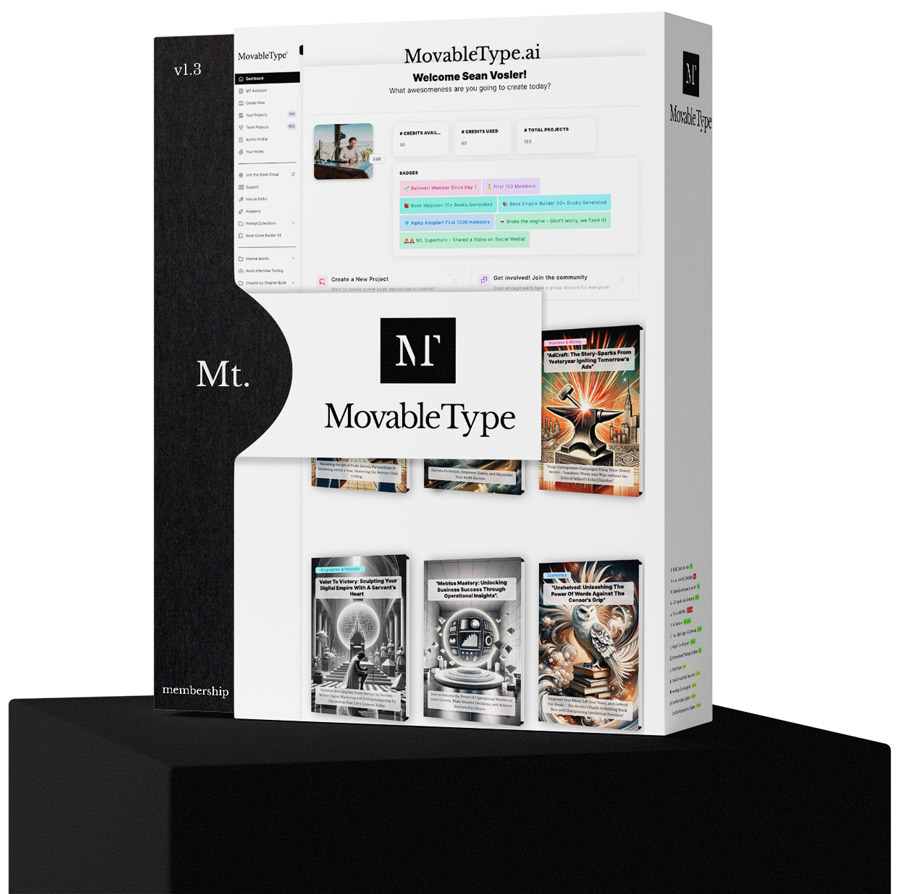
- By: Sean Vosler
Embrace the Power of AI-Assisted Writing and Uncover a New Frontier of Creativity.
Your Book's Introduction - "The Preface"
Congratulations! Your book aced the “judge a book by its cover” test. But the journey doesn’t stop there – next up is the intro or “Preface.” At this phase, MovableType carefully engineers the preface to serve as an engaging “sales letter” designed to hook your readers, keep them engaged, and start the bond that will be nurtured between you and the reader moving forward.
Most writers are tempted to only talk about themselves in the introduction, but this is the opportune time to help your reader understand why THEY will benefit from reading your book.

Paige Turner
Your Project Guide
Preface
"The greatest danger in times of turbulence is not the turbulence; it is to act with yesterday’s logic." – Peter Drucker
In a tapestry where words intertwine with the binary pulse of artificial intelligence, The AI Writer's Odyssey: Crafting Non-Fiction Literature in the Age of Generative AI emerges as a beacon of guidance. This book unfurls the narrative of blending human creativity with the relentless efficiency of AI to weave non-fiction that still bears the soulful touch of its writer.
I penned this odyssey inspired by the uncertainty that shadows many aspiring writers when they confront the prospects of AI. Like a candle flickering to challenge the dusk, I observed individuals hesitant to entrust their stories to an algorithm, fearing the erosion of authenticity and creativity. It is through the lens of these shared vulnerabilities that the purpose of this book crystallized – to illuminate the uncharted waters of AI-assisted non-fiction writing, ensuring the writers' craftsmanship remains undiminished and emboldened.
I've met many who, like you, stand at the crossroads of tradition and innovation. One particular individual, Emma, a seasoned journalist, echoed the common refrain: the trepidation of diluting one's own voice in exchange for the efficiency of a machine. It was her journey of discovery – from skepticism to adoption, culminating in a harmonious symphony with AI – that inspired the heart of this book. Emma's experience offers a glimpse into the transformative potential of technological partnership, without forgoing the essence of human touch.
In crafting this odyssey, I drew inspiration from the tenets of MovableType.ai, the wellspring of innovation founded under my stewardship. I am grateful for the collaborative warmth of previous teams, such as Jasper.ai, who share the vision of storytelling democratization. But beyond these technological marvels, it's the testament of countless unwritten stories yearning for a voice that fuels this journey.
To those who have chosen to spend moments of your life with these pages, your curiosity is a gift I treasure. This book seeks not to preach from an ivory tower but to walk beside you, mirroring the assuring hand of a mentor. Its wisdom is fashioned to resonate with aspiring non-fiction writers, storytellers seeking to retain their individuality, and explorers of ethical considerations in the age of AI. For those venturing here, an open mind is the sole prerequisite as we navigate this transformative conjuncture together.
A vast sensory palette awaits you, from the novelist inhaling the musk of a dusty library corner to the scriptwriter who hears the distant echo of applause for a yet-unwritten play. Poised with a conversational embrace, I aim to infuse insight to your imagination, engaging your senses, and fostering a vivid understanding of the potential friendship between human writers and artificial muses.
With each chapter, I invite you to savor the taste of newfound knowledge, to feel the texture of each concept, and to see the horizons of writing expand before you. Trust in the blend of human ingenuity and AI as the loom on which the fabric of your storytelling is woven.
In gratitude for your purchase and commitment to the cascade of words before you, I beckon you onwards. Let's embark on an odyssey together – not just to reach the end but to uncover a treasury of solutions and pathways that will shape your writing destiny.
Shall we begin?
Your First Chapter
The first chapter is like the front porch of a book. It invites your readers in, gives them a glimpse of what’s inside, and warmingly invites them to step through the door. MovableType crafts the first chapter to directly address the central issue or problem the book revolves around. This approach ensures that the initial chapter delivers a clear and compelling solution, setting the tone for the book’s overarching theme.

Paige Turner
Your Project Guide
Chapter 1: Adapting to the Technological Landscape
The clatter of a mechanical keyboard under a writer's hands often feels like an old friend, but for Jonathan, today it sounded more like an alarm. Each keystroke reverberated against the walls of his small, cluttered office, filled with towering piles of books and discarded coffee cups. Jonathan, a seasoned non-fiction writer, was wrestling with a dilemma—the pressing need to adapt to the new technological advances that were rapidly overtaking his craft.
Outside, the sun threw its midday beams indiscriminately upon the vibrant city life, people in casual wares of business and leisure intersecting like a Rembrandt, masterfully painted in broad strokes of light and shadow. Inside, Jonathan was very much alone with his thoughts, which swirled like leaves caught in an autumn gust. The digital age, a once-distant horizon, now loomed over him like an unforgiving wave ready to crash.
Laptops and tablets had replaced paper and pen, social media demanded a constant stream of content, and search engine optimization had turned once-stately prose into formulaic sentences. Jonathan's reliable typewriter seemed like an artifact from a bygone era, a remnant of a time when words held weight and pacing was a revered art form. The click-clack of its keys had been a comforting rhythm, a lullaby for his thoughts. Now, it was replaced by the soulless tap-tap-tap of the backlit keyboard of his new laptop, a gift from his daughter meant to 'improve efficiency.'
He paused, sighed, and rubbed his temples. Once again, a neighbor's dog barked, piercing through the placid hum of air conditioning, reminding him of the world outside his textual haven. People were adapting, thriving even, within this new digital realm. Why couldn't he? Jonathan feared irrelevance, a fate worse than writer's block. He recalled a young reader telling him that his work could be "more accessible" had he been plugged into the current digital trends. The subtle sting of that memory lingered.
Jonathan pondered how mastering these newfangled tools could elevate his work—perhaps even grant him the means to reach a broader audience. He imagined his words radiating across the globe through the internet's vast network, igniting discussions and touching lives. Yet, could the depth of his experiences and the richness of his knowledge translate through the pixels on a screen as they did on the textured pages of his books?
As the world continued to hum and buzz around him, with cars zooming past and the distant murmur of city life serving as a backdrop to his isolated contemplation, he considered his next steps. The careful crafting of each sentence, the diligent work required to inform and educate—it had always been a labor of love. Now, it seemed, it was time to evolve that love, to blend the timeless art of storytelling with the ceaseless pulse of progress.
It was a peculiar crossroads, one paved with uncertainty and nostalgia, but also opportunity. Will the allure of technology be the savior of his craft, or will it dilute the essence of his voice in a sea of digital noise?
Embarking on a Journey Through the Digital Quagmire
As we stand at the threshold of an unprecedented evolution in the art of the written word, an undeniable truth confronts us – adapt or be left behind in the pages of history. Non-fiction writers, charters of reality and truth, are facing a transformative horizon where their traditional tools of trade are being reshaped by the relentless forge of technology. In this new era, peppered with algorithms and artificial landscapes, a non-fiction scribe must don the mantle of adaptation to sustain relevance. Allow me to guide you through the intricacies of crafting non-fiction literature with the support of generative AI, proving that the pen is not only mightier than the sword but also more innovative than the code.
Our odyssey begins by establishing a framework, a scaffold upon which we can build understanding and skill. This framework, drawn from the well of Systems Theory, provides a conceptual model to parse the complexities of AI-assessment writing in non-fiction literature. Here we thread the needle, weaving together the four primary elements: AI as a tool, the writer as creator, interaction and collaboration, and ethical considerations. Imagine this as our compass, a navigational aid to steer through the digital ecosystem.
AI as a Tool invites you to look beyond the screen and into the mechanisms where AI technology becomes an extension of the writer's mind—an arsenal of tools brimming with natural language processing capabilities, text generation algorithms, and data analysis techniques. I urge you to envisage AI not as a usurper of creativity, but as an enigmatic muse, offering its services to refine and amplify the writer's expressive powers.
When considering the Writer as Creator, we touch upon the essence of what it means to write – the human experience, wisdom, and raw creative force. This component reiterates the paramount importance of the individual writer's voice and judgment, positioning AI as a magnifying glass that enlarges one's creative potential rather than a shadow that dims the author's personal flair.
The dance of Interaction and Collaboration delineates the symbiotic waltz between human intellect and artificial cogitation, a partnership that engenders superior quality in non-fiction literature. Here, AI becomes more than a mere tool; it becomes a colleague, a co-writer that brings forth ideas, hones the writer’s work, and enriches research. This alliance, when cultivated, can blossom into an intellectual camaraderie that pushes the boundaries of non-fiction narrative beyond its conventional contours.
Stepping into the realm of Ethical Considerations, we acknowledge the moral compass that must guide this joint venture. The realm of AI-assessment writing is fraught with potential pitfalls – authorship attribution, plagiarism, the transparency of AI contributions – compelling us to tread carefully, responsibly, and with a clear commitment to authenticity.
As we dissect these components, take note of the dynamics at play. Our model is alive, pulsating with interactions where feedback loops and adjustments maintain the equilibrium between machine assistance and human creativity. This fine balance must persist through the evolving conditions of our technological landscape for truly enlightened non-fiction literature to emerge.
Harmonizing the Symphony of Synapses and Circuits
Pivoting towards the practical implications of our model leads us to the writer's desk, where the systemic framework transforms into a concrete strategy for writing non-fiction literature. The real-world application of our conceptual model underlines its merit as writers harness AI to reach new pinnacles of narrative excellence, while concurrently navigating the ethical landscapes with sagacity and grace.
Within this introduction, we have only just begun to chart the expanse of the AI Writer's Odyssey. As we delve deeper into subsequent chapters, we will explore how generative AI becomes a co-creator in the writing process, reconcile the balance of AI and human creativity, and venture into new territories of ethical, philosophical, and creative perspectives. Throughout this journey, your role as a non-fiction writer will evolve, flourish, and redefine what it means to pen truth in the age of generative AI.
With this orchestrated framework, I invite you to brace yourself as we embark on a transformative exploration of your craft. Step forward with an open mind and a willing spirit, ready to discover how adaptation to the fusion of synapses and circuits can unfurl new creative horizons, ensuring that your voice remains indispensable within the chorus of the digital age.
The Imperative of Adaptation
In an era where technology is as ubiquitous as the air we breathe, the traditional craftsman must evolve or risk obsolescence. Non-fiction writers are no different; their quills must transform into digital pens to keep pace with advancement. To ignore this is akin to refusing a compass on a voyage across uncharted waters. The embrace of modern tools is not an option but a necessity for those who wish to chart the course of informed discourse.
Imagine a carpenter working with antiquated tools while his peers utilize electric saws and precision instruments. His dedication to craft is admirable, yet as the world builds skyscrapers, his hands can only erect cabins. Non-fiction writers with an aversion to technology are like this carpenter, holding onto hand saws in an age of power tools. The need for adaptation is clear, and resistance can be a disservice to their skill and message.
The statistics are revealing: from digital publishing platforms to online research databases, the resources at a writer's disposal have expanded exponentially. Notions of accessibility and visibility have been redefined by the internet, empowering those who leverage these tools to reach broader audiences than ever before. It's a renaissance of reach, and writers are its potential masters, but only if they wield the tools that make such mastery possible.
Traditional writers may view this technological push as an existential threat. However, history reminds us that adaptation is the heartbeat of longevity. From the printing press revolutionizing literacy to the internet democratizing knowledge, each technological leap has been a door to new realms of possibility. For the contemporary writer, this means integrating software that can support research, organization, and dissemination of thought with unprecedented efficiency.
In a transformative era, understanding the importance of adapting to technological advancements isn't just a learning objective—it's essential survival knowledge for the non-fiction writer.
The Blueprint for Integration
Ingenious Initiation: Setting Up Your AI Writing Assistant
In the quest for relevance amidst evolving technology, recognizing the utility of new writing instruments is paramount. The brilliance of a painter lies not just in their vision but in their choice of brush and canvas. For writers, tools such as AI writing assistants are the new pigments adding vibrancy to the canvas of non-fiction literature.
Embracement of these tools can yield advantages such as enhanced efficiency, improved quality of research, and richer engagement with audience—all signposts pointing non-fiction writers towards continual relevance. The truth is, technology is not a wave to outrun, but one to ride with adept balance.
Step 1: Install AI Writing Assistant Software
Allocate 15 minutes to download and install the preferred AI writing assistant. This digital companion will be indispensable as you embark on the literary odyssey ahead.
Step 2: Create an Account
Spend about 10 minutes setting up your account. Be thorough and precise, for this is the foundation upon which your digital writing endeavors will be built.
Step 3: Set Preferences
Take about 20 minutes to tailor the assistant's settings. The ink of this era is digital, and within it lies the choice of hue—tone, style, and language—so essential to the writer's craft.
Step 4: Familiarize Yourself with the Interface
Dedicate 30 minutes to navigating the landscape of menus and options. Mastery of this terrain ensures that the AI writing assistant becomes more than a tool—it becomes an extension of the writer's intent.
Step 5: Connect to Reference Materials
Invest 15 minutes to link up with libraries and databases. Just as rivers nourish fields, so does well-channeled information nurture the crop of knowledge awaiting harvest in non-fiction writing.
Step 6: Run Initial Test Sessions
Set aside an hour for exploratory skirmishes with prompts and content generation. Understand the assistant's capabilities as a blacksmith understands his forge and hammer.
In constructing this partnership with the AI writing assistant, the non-fiction writer gains a toolkit whose powers lie waiting to be harnessed. Writers should approach each step with the keenness of a sculptor selecting their chisel, carving out a space for themselves in the digital era's gallery.
What if the next level of your writing craft is just an AI assistant away?
The Craft Enhanced
Just as the blacksmith finds his artistry elevated through the furnace's heat, so may the writer discover their craft refined by the fire of technological change. Drifting through the digital age without harnessing its potential is akin to sailing a vessel with no wind in its sails. The adoption of AI writing assistants and similar advancements invigorates the sails and sets writers on a course of discovery.
Writers who adapt become architects of information, constructing narratives bolstered by data with precision and unassailable logic. The tools at our disposal serve as extensions of our imagination and determination, morphing the daunting mountains of potential information into scalable hills, navigable with a series of keystrokes.
Technology offers a palette from which writers can paint truths in ever-more striking colors, capturing the imagination and intellect of readers across the globe. Research, once a journey through physical archives, is now a trek across digital landscapes, with AI amplifying the writer’s reach and capability.
AI's impact on non-fiction writing is a testament to the synergy between human creativity and machine precision. The meticulous task of proofing, for example, once consuming hours of a writer's time, can now be achieved with the help of artificial intelligence, thereby liberating the writer to soar into the realms of deeper thought and expression.
By embracing these changes, writers not only remain relevant but also carve new paths to excellence. Non-fiction literature is not a static monument but a living, evolving organism, and technology infuses it with vigor and potential.
The journey through this chapter has guided non-fiction writers to understand the need for adaptation, recognize the benefits of embracing new tools, and discover how doing so can enhance their craft and relevance.
Embrace the Future of Writing
Congratulations! You have now embarked on an exciting journey into the future of non-fiction writing, where the ever-evolving technological landscape opens up a world of possibilities. In this chapter, we explored the need for writers to adapt and embrace advancements in technology. We discovered the benefits of using new tools and approaches to stay relevant in a rapidly changing world. We also delved into how adapting to technological changes can enhance writing craft and maintain relevance in the digital age.
As non-fiction writers, we must be adaptable and open to new ways of creating and sharing our work. The advancements in technology may seem daunting at first, but they also bring immense possibilities for us to explore. By embracing these changes, we can stay relevant, engage with our readers, and continually enhance our writing skills.
So, what exciting benefits await you by reading this book? The AI Writer's Odyssey is designed to empower you with the knowledge and tools to navigate the changing landscape of non-fiction writing. You will discover how to harness the power of AI-assisted writing and uncover a new frontier of creativity. This book is your guide, your companion, and your source of inspiration as you embark on this transformative journey.
Imagine being able to access a wealth of information at your fingertips, effortlessly highlight key concepts, and receive real-time feedback on your writing. With technological advancements, you can enhance your research, streamline your workflow, and present your ideas with clarity and precision. The AI Writer's Odyssey will equip you with essential strategies and practical advice to leverage these tools effectively, ensuring that you remain at the forefront of the writing world.
But this book is not just about technological tools, it is about empowering you as a writer. It will guide you through the process of adapting to these changes, helping you maintain your unique voice and perspective in a digital landscape. By exploring the intersection of technology and creativity, you will learn how to embrace and leverage the power of AI to amplify your impact as a non-fiction writer.
In the chapters to come, we will explore different techniques, strategies, and ethical considerations surrounding AI-assisted writing. We will delve into the vast expanse of possibilities that AI offers, while staying grounded in our role as writers and custodians of knowledge. We will uncover how AI can help us tackle complex topics, engage with diverse audiences, and wield the written word with even greater impact.
So, dear reader, as we conclude this chapter, I invite you to embrace the future of writing. Together, let us embark on an adventure that will challenge, inspire, and transform the way we write non-fiction literature. The AI Writer's Odyssey awaits you, ready to empower you on this journey of exploration and self-discovery. Get ready to embrace the power of AI-assisted writing and unlock a new chapter in your writing career. The possibilities are endless, and the future is yours for the taking.


